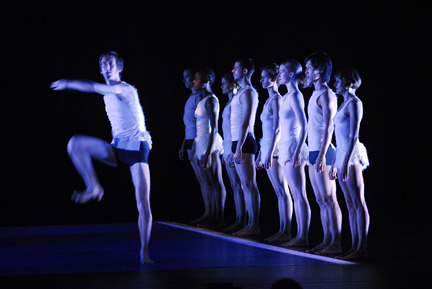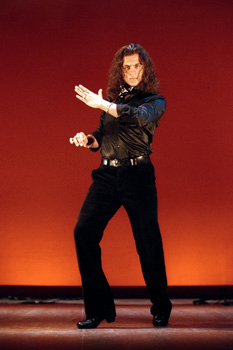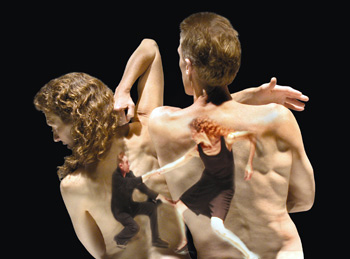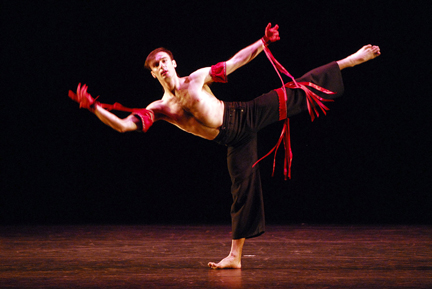Scenes from the Buffet
Fall for Dance
Pacific Northwest Ballet/Christopher Williams/Random Dance/Bridgman Packer Dance/Farruco
City Center
New York, NY
October 5, 2006
by Leigh Witchel
copyright ©2006 by Leigh Witchel
 It’s human nature to like grazing among choices, noshing a bit, sampling sweets here and savories there. Fall for Dance continued to present its nonstop buffet of dance at City Center; these were Thursday night’s dishes.
It’s human nature to like grazing among choices, noshing a bit, sampling sweets here and savories there. Fall for Dance continued to present its nonstop buffet of dance at City Center; these were Thursday night’s dishes.
Pacific Northwest Ballet opened the evening with “The Piano Dance”, by Paul Gibson, one of the company’s ballet masters. Set to piano pieces by composers from Chopin to Bartok, it’s a buffet itself, but not one that goes together well. The opening, to John Cage, places the ballet in sleek modern territory, but then there’s a romantic pas de deux to, of all things, Chopin’s Prelude No. 4 (the one from the umbrella scene in “The Concert”). Choreographers who are going to make that kind of transition need to take us along with them, or else it’s like finding a salmon fillet in your wedding bouquet. Both are desirable but what are they doing together? Gibson is competent at putting together combinations and the dancers are more than competent at doing them; by and large the PNB dancers look finely bred. Louise Nadeau is still going strong entering her fifteenth year as a principal dancer; Chalnessa Eames gave an independent, modern twist to a pas de deux where she enjoyed Josh Spell’s body much as he might have enjoyed hers. The dance needs more intellectual acuity; using music that’s familiar from other ballets is also a problem. The Ligeti has been used by Wheeldon, the Cage by Martins, the Chopin . . . well, surely Gibson has seen “The Concert”? The music may not be familiar to Seattle audiences and a choreographer needs to make journeyman works. Even so, bringing to City Center good dancers in choreography that isn’t distinctive enough to hold its own against previous versions makes the company look provincial, and worse, reinforces the stereotype of ballet wasting great dancers on unremarkable dances.
 Wayne McGregor’s “Polar Sequences” for Random Dance is true to the company’s name, as random a buffet as Gibson’s, but it’s a trendier one. Instead of tidy piano pieces, we heard Purcell’s haunting “The Plaint” abruptly switched off and supplanted by industrial music, and then followed by Marilyn Manson. Fine and dandy if you can show us why, by McGregor doesn’t bother. Along with the incongruity of the music used, McGregor isn’t particularly musical; his movement phrases look as if they’ve been choreographed first and then the music turned on. Perhaps he has experienced some hearing loss from the music’s volume. The contemporary movement was familiar thrashing mixed with brief moments of stillness before the flailing picked up again. “Polar Sequences” was opaque in purpose apart from a desire to seem cutting edge and went on way too long. If I’m going to be subjected to attack dance, let it be from someone like Forsythe who’s a better choreographer. It may just be a generation gap; most of the younger people in the audience had no quarrel with the cut and paste structure of “Polar Sequences” and loved the dance as well as the fine dancers. What’s the matter with kids today?
Wayne McGregor’s “Polar Sequences” for Random Dance is true to the company’s name, as random a buffet as Gibson’s, but it’s a trendier one. Instead of tidy piano pieces, we heard Purcell’s haunting “The Plaint” abruptly switched off and supplanted by industrial music, and then followed by Marilyn Manson. Fine and dandy if you can show us why, by McGregor doesn’t bother. Along with the incongruity of the music used, McGregor isn’t particularly musical; his movement phrases look as if they’ve been choreographed first and then the music turned on. Perhaps he has experienced some hearing loss from the music’s volume. The contemporary movement was familiar thrashing mixed with brief moments of stillness before the flailing picked up again. “Polar Sequences” was opaque in purpose apart from a desire to seem cutting edge and went on way too long. If I’m going to be subjected to attack dance, let it be from someone like Forsythe who’s a better choreographer. It may just be a generation gap; most of the younger people in the audience had no quarrel with the cut and paste structure of “Polar Sequences” and loved the dance as well as the fine dancers. What’s the matter with kids today?
 Every buffet needs exotic delicacies; Farruco provided them. Along with two guitarists, two singers and a fellow flamenco dancer, Barullo, he burst onto the stage like four and twenty birds of paradise baked in a pie. The two men competed in a blur of footwork. Rather than traditional costumes, they wore suits, for his solo Farruco changed into a blue cutaway jacket. The costumes recalled those for tango, and the fact that it was first danced between men. The preening masculinity of a male flamenco duet takes adjustment for those not accustomed to it; it was as if they were bucks colliding in spring.
Every buffet needs exotic delicacies; Farruco provided them. Along with two guitarists, two singers and a fellow flamenco dancer, Barullo, he burst onto the stage like four and twenty birds of paradise baked in a pie. The two men competed in a blur of footwork. Rather than traditional costumes, they wore suits, for his solo Farruco changed into a blue cutaway jacket. The costumes recalled those for tango, and the fact that it was first danced between men. The preening masculinity of a male flamenco duet takes adjustment for those not accustomed to it; it was as if they were bucks colliding in spring.
The performance was in two parts, a duet with Barullo and then a solo. The musicians and singers introduced both sections; part of the mystique of flamenco is the informal play between the musicians and the dancers. Barullo was compact; he grabbed the bottom of his suit jacket and twisted it round himself before an outburst of stamping. Farruco was more florid, doing almost imperceptible stamps across the floor with ferocious concentration and then whirling into a turn or rivoltade and standing exhausted to accept the audience’s adulation. He comported himself like a legend; the crowd responded by treating him like one.
Christopher Williams performed a short solo, “ginja sem caroço”, from his “Portuguese Suite”. The program notes that the dance was about “the impact of traditional society on an intercultural gay relationship.” The brief excerpt only hinted at that; what was obvious was Williams’ gifted facility and lush movement. In the great tradition of modern dancers, his choreography provided him with his ideal repertory.
 The surprise dish at City Center’s buffet was an unassuming one; an excerpt from Bridgman/Packer Dance’s “Under the Skin.” Brief, witty and ingenious, the dance was as much theater as movement; the couple functioned as a human movie screen. In the dark and with their backs to us, they moved slowly as images were projected on to them; some resembled skeletal structures, others were smaller images of both dancers. The images became ever-changing costumes. The second part of the dance was entrances and exits through slits in a black curtain, with a film superimposed of yet more entrances and exits, also through a black curtain. One rarely knew what was dancer and what was projection; the excerpt astutely ended before the amusement wore thin. Bridgman/Packer amiably succeeded at the point of Fall for Dance’s buffet; to lure us with familiar dishes that we enjoy in the hopes we’ll find the unfamiliar ones tasty enough to try again.
The surprise dish at City Center’s buffet was an unassuming one; an excerpt from Bridgman/Packer Dance’s “Under the Skin.” Brief, witty and ingenious, the dance was as much theater as movement; the couple functioned as a human movie screen. In the dark and with their backs to us, they moved slowly as images were projected on to them; some resembled skeletal structures, others were smaller images of both dancers. The images became ever-changing costumes. The second part of the dance was entrances and exits through slits in a black curtain, with a film superimposed of yet more entrances and exits, also through a black curtain. One rarely knew what was dancer and what was projection; the excerpt astutely ended before the amusement wore thin. Bridgman/Packer amiably succeeded at the point of Fall for Dance’s buffet; to lure us with familiar dishes that we enjoy in the hopes we’ll find the unfamiliar ones tasty enough to try again.
Photos, from top:
Pacific Northwest Ballet iin The Piano Dance.
Photo by: © Angela Sterling.
Random Dance Company performs "Polar Sequences. Photo: Stephanie Berger
Farucco. Photo: Rose Marb.
Bridgman/Packer in "Under the Skin."
Photo by: Kelly Gottesman
and Lisa Levart.
And below, Christopher Williams in "ginga sem caroco." Photo: Stephanie Berger

Volume 4, No. 36
October 9, 2006
copyright ©2006 Leigh Witchel
www.danceviewtimes.com